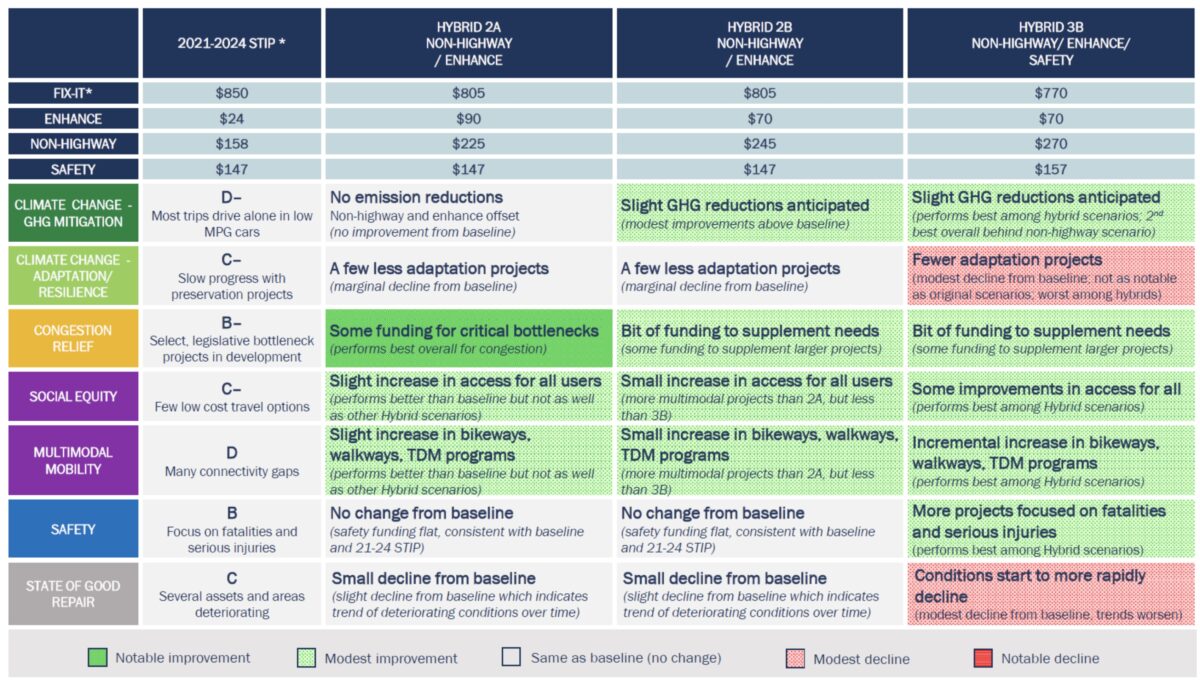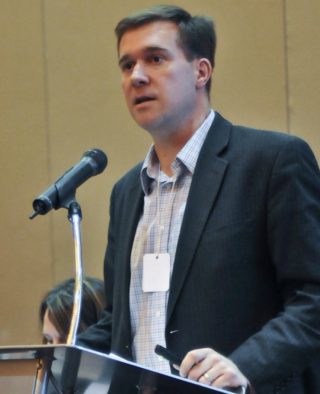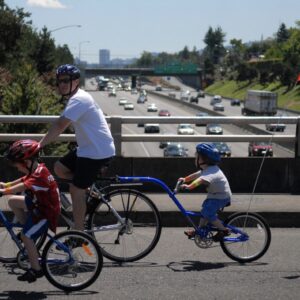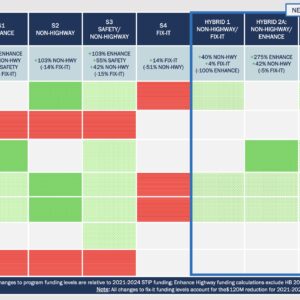
“I would take the win and recognize this is a big step forward for the state.”
— Travis Brouwer, ODOT
A decision that impacts $2.2 billion in transportation spending by the State of Oregon is poised to take a significant step forward on Friday (12/11). As we shared last week, a vote on the Oregon Department of Transportation’s 2024-2027 Statewide Transportation Improvement Program was set to happen December 1st, but was delayed after ODOT staff threw a few curve balls into the process.
After months of public process on four funding “scenarios”, ODOT introduced two new ones just one week ago — the day before the Oregon Transportation Commission (OTC) was going to vote on them. Detailed analysis of the new proposals wasn’t made public until during the OTC meeting just hours before an expected vote. When it was, we realized there were actually four new funding scenarios on the table. This caused a stir both among OTC members who were reasonably overwhelmed at now having eight different scenarios to ponder, and transportation advocates who worried ODOT was trying to rush major changes through without adequate public scrutiny.
Advertisement

This morning Bike Loud PDX launched a “Stop the STIP” campaign, urging people to contact the OTC with concerns about ODOT’s public process and encourage them to devote more funds to the Non-Highway category. Bike Loud also contends that ODOT is not following its own public involvement policy which requires a 45-day public comment period before any “major updates” to the STIP prior to OTC adoption. (ODOT says this policy applies only to STIP adoption, not to minor preliminary steps like this one.)
Before we get into details and dollar amounts, I feel like ODOT has some explaining to do. On that note, this morning I spoke with the man running point for ODOT on this process: Assistant Director for Revenue and Finance Travis Brouwer. Brouwer, who worked in ODOT federal and public affairs before moving into his current role last year, said there’s nothing nefarious going on.

(Photo: Jonathan Maus/BikePortland)
I asked Brouwer how he squares claims of a robust public process with introducing new plans at the last minute. He said changes to the original funding plans were necessary because none of them received a convincing mandate. “The hybrid scenarios were based on the outcome of public comment and are really trying to find a way to incorporate the various major themes from that public comment into a consensus scenario that we thought would have public support,” Brouwer explained.
Pressed on his last-minute actions at the OTC meeting last week, Brouwer acknowledged it was not ideal. “I do agree with you that, ideally, we would have the same amount of time for people to comment on every layer of this,” he said. Brouwer compared these adjustments with the legislative process where a bill is scrutinized by voters and then amended by legislators prior to passage.
The way Brouwer sees it, the changes from the original scenarios to the ones currently on the table are “fairly minor” and are merely attempts to, “smooth out some of the rough edges.” Brouwer felt that one of the major themes from public comment was that more needs to be spent on “Non-Highway” and “Safety” categories — but that it couldn’t come by moving too much out of “Fix-it” and “Enhance” — which in ODOT’s view would hasten deterioration of roads and bridges to unsafe levels.
Last week (12/4), ODOT released a memo (PDF) with the three funding scenarios that will be voted on Friday. The names of the new funding scenarios are: Hybrid 2A Non-Highway/Enhance; Hybrid 2B Non-Highway/Enhance; and Hybrid 3B: Non-Highway/Enhance/Safety. (Note that the five OTC members agreed at their meeting Tuesday (12/1) to discard the original four scenarios and focus on new ones.)

If you’re a fan of the Non-Highway funding category, ODOT’s changes might not feel “fairly minor”. The original Non-Highway funding scenario vetted through months of public process that earned support of advisory bodies and advocacy groups statewide had $320 million of Non-Highway category investment — a 102% increase over the previous STIP. None of the three new Hybrid scenarios come close to that level of Non-Highway funding and represent a decrease of between $69 million (a 42% increase over previous STIP) in Hybrid 3B to $114 million (a 26% increase over previous STIP) in Hybrid 2A compared to the original scenario.
[You can submit comments and testimony on the new scenarios to OTCAdmin@odot.state.or.us before Wednesday (12/9) at 12:00 noon.]
While the Non-Highway funding allocation goes down significantly in the new scenarios, the Fix-it category goes up. It’s still below levels of the previous STIP, but well over any of the four scenarios ODOT originally proposed to the public. The original scenarios would have cut Fix-it by a minimum of 14% compared to the previous STIP. Current Hybrid scenarios would reduce Fix-it spending by just $45 million (5.6%) or $80 million (10%), depending on which one is chosen.
Advertisement

“The STIP is just one of the tools we have to impact climate, and not necessarily even our most effective.”
— Travis Brouwer, ODOT
It’s also glaring that, given the existential crisis posed by climate change, none of ODOT’s proposed funding scenarios would make significant gains in greenhouse gas emission reductions. As you can see in the chart above (a detail of our lead graphic), the Climate Change/GHG Mitigation grade for the current STIP is a D-minus — the lowest grade of all seven measured outcomes (the other being Multimodal Mobility, which gets a D).
“The STIP is just one of the tools we have to impact climate, and not necessarily even our most effective,” Brouwer replied when I asked him about this. He said the agency is working on pricing road use, changing land-use, and boosting transit service. “Ideally, the investments we make in the STIP will allow all those other tools to more effectively address climate,” he added.
Brouwer also downplayed the importance of the STIP when it comes to non-highway funding: “The dedicated, non-highway, state and federal funding in the STIP is only 20% of the total dedicated state and federal non-highway funding we have available, so that’s where you’ve got to look at the rest of the picture, to get a sense of what the total playing field is.”
As for that big picture, Brouwer says people should step back a bit and look at it. “The level of non-highway funding in this STIP, regardless which scenario they select, will be unprecedented,” he said. “It will likely be record levels of non-highway funding, an extra $75 to $100 million.”
Instead of fighting the process, Brouwer says, “I would take the win and recognize this is a big step forward for the state, and that we need to then continue that work at the legislature and other places.”
— The OTC meeting to debate and pass the STIP funding scenarios is set for 8:00 am on Friday. Comments and testimony are accepted via email to OTCAdmin@odot.state.or.us before Wednesday (12/9) at 12:00 pm. Hear more from Brouwer in a segment on OPB’s Think Out Loud radio show that aired today (12/7).
— Jonathan Maus: (503) 706-8804, @jonathan_maus on Twitter and jonathan@bikeportland.org
— Get our headlines delivered to your inbox.
— Support this independent community media outlet with a one-time contribution or monthly subscription.






Thanks for reading.
BikePortland has served this community with independent community journalism since 2005. We rely on subscriptions from readers like you to survive. Your financial support is vital in keeping this valuable resource alive and well.
Please subscribe today to strengthen and expand our work.
“Take the win” and move on?? The ODOT official seriously thinks that a D-minus climate plan is a “win”?
My take is that ODOT, and state gov’t generally, are under enormous pressure to continue building and widening roads and highways. They hear it from every direction: businesses want faster delivery routes; commuters want shorter car-commutes; parents want their school runs (pre-covid) to be four minutes shorter so Alex and Skylar don’t have to brush and rush; families want to load into the Yukon for a weekend road-trip and don’t want to sit in traffic. Lost in the complaining is what we’re doing collectively to the environment as we pollute the air and destroy the climate. Government and its agencies, like ODOT, aren’t leading – they are following. I hate to sound cynical but I’m convinced that in the absence of actual leadership nothing will change til a catastrophe visits every American in every community.
I think you’re spot on. Kate Brown can sign the executive order, but she can’t take a stand against Rose Quarter, broken STIP, etc. because she would be ruined politically. Environmental groups really need to find a way to build a coalition that can support disinvestment in highways.
But, she could appoint Commission members with a more ‘flexible’ philosophy, without riling too many folks. I also wonder how/why you think that she would be ruined politically with the abovementioned stands? Seems like it would just garner more support from her base.
She could do that but she hasn’t. Widening highways has a broad coalition: suburbanites who rely on them; road builders, unions, engineers, consultants, and material suppliers who will profit; and freight companies. There is also institutional inertia at ODOT. I’m not saying Kate has an easy job, and I generally support her, but it’s a shame she hasn’t said anything about Rose Quarter in particular after Portland leaders pulled out. The project only continues because of the state, and she is the head of state.
Errrmmm…Kate Brown has been primary political force in the Oregon Democratic party that has pushed for highway expansion (and she thanks you for your “general support”).
I wish I could give this comment more than one “thumb’s up”!
Agree with your everything (extra credit for Alex and Skylar), but as a point of clarificaiton: the D- climate is for the existing 2021-2024 STIP. It doesn’t look like ODOT assigned letter grades to the 2024-2027 scenarios under consideration. So we just know it’s a “modest improvement” over a D-.
I guess ODOT Public Misinformation Officer Don Hamilton is on vacation? Did he leave a memo for Mr. Brouwer reminding him to be as condescending as possible in discussions with ODOT’s constituents?
I actually thought he was pretty open and transparent for a government official. Bigger point is where is Kate Brown on all this? It is my understanding (correct me if I am wrong), that she appoints the Commission members. Sounds like maybe your ire is misdirected.
Oh come on. This is clearly a play on “stop the steal”. Co-opting language that Trump supporters are using does us no good, and just discredits us in our quest for safer and more environmentally-friendly transportation. And yes, I get that I’m attacking the message here more than the content itself, but messaging matters, which I think is something that progressive activists lose sight of too often.
My thoughts exactly. Basing your slogan on the one used by a moronic right wing coup attempt? You’re dead on arrival. Who thought that was a good idea?
“Defund Highways”.
When I look at the chart and trade-offs, it seems obvious to me that ODOT planners were counting on two things last November 3rd: Passage of the Metro transportation package for more funding for “non-highway” projects (so other funding could be allocated elsewhere) and either a narrow Trump victory (more funding for highway projects) or else an overwhelming Biden victory (massive new funding for transit, bike, and walk projects.)
Now the reality is setting in. Biden has a narrowly divided congress, so no Green Deal, just the usual conservative allocation of not enough highway funding. There ain’t enough money to go around. What are y’all gonna cut?
And so you get a series of minor tweaks to a very austere highway budget, not enough funding for anyone – everyone will go home unsatisfied.
But it could be worse. Here in NC, the entire state transit subsidy and most bike/walk funding was cut to certain highway projects could be completed, by a Republican-controlled legislature and by a re-elected Democratic governor.
Some of this may be the case, and some individuals may have been thinking this specifically, but I think the larger institutional process was prepared to put forth their four options, choose the one with all the highway spending and call it a day.
However, in the face of public feedback that opposed the “Enhance” option (the names really give away the game in this exercise) in favor of safety and non-highway spending (as if those aren’t related at all), they decided they would create new options that preserve more of the highway spending and pit safety and non-highway spending against each other. Now we’re stuck with four “solutions,” all of which to some degree further ODOT’s institutional goals of more and bigger highways everywhere.
Sidewalks and safety investments for Communities of Color? That’ll require a public vote.
Expensive road expansions for white suburbanites? That’s baked into the funding formula.
I thought all the POC were pushed to the suburbs because of the high price of housing in Portland.
Freight has more influence on ODOT than all other stakeholders combined. Trucking Lobby cares nothing about the environment, pedestrians, cyclists, communities of color, or the best interests of the citizenry. They own the OTC and OTC worships at the alter of Through-Put at the expense of any and all other priorities. Money talks and Freight spends money
This is true because OUR SOCIETY worships convenience and “things” being easy. This will not change until it is far too late. Folks think technology solves the freight issue. Funny stuff. There is no “APP” to solve this. Just keep staring at your phone. If most are not present than nothing will improve.
Freight of course includes FedEx, UPS, the postal service, Amazon Prime, the food delivered to our stores and homes, all merchandise, and so on – we are all of us both dependent upon it and perpetrators of its influence on ODOT and the OTC. We have met the enemy and thems are us.
Bike Loud is always relevant and on point. Will someone with more money than me please donate SOMETHING to them before 2020 is over PLEASE?
Where do the other advocacy groups (ie oregonwalks, street trust) stand on this? Why are we only hearing from bikeloud?
Can someone please post instructions on how to submit comments on the new proposal?
You can submit comments and testimony on the new scenarios to OTCAdmin@odot.state.or.us before Wednesday (12/9) at 12:00 noon.
Thanks. Testimony submitted.
A major problem with the advocacy of many nonprofits is that their politics are reactive and lack a theory of change. For example, cancelling the I5 Rose Quarter Highway expansion does little to lower the steadily increasing transportation-associated emissions in Portland. Likewise, even in the unlikely event that the OTC capitulates to vague demands, most of the non-highway funds would be spent on infrastructure that has little impact on alternatives to the car/truck (e.g. recreational facilities/paths, airports, marine infrastructure, trains etc).
Unless active transportation advocates and nonprofits stop voting for and enabling democrats (e.g Kate Brown) I very much doubt this reactive dynamic will change.